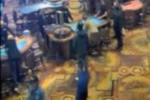Nature-themed décor takes romance out of porcelain
French porcelains were among the best-decorated in the world in the early 19th century. Porcelain painters worked at many factories making richly decorated ornamental and useful porcelains. These early pieces had expertly painted bunches of flowers and landscapes, often embellished with gold trim. But styles change, and by the 1870s, heavier, less romantic decoration was needed to go with the ornate carved furniture of the Victorians.
Bernard Palissy, a French potter working about 1510 to 1590, was a naturalist. He made pottery platters like little ponds covered with realistic raised copies of snakes, lizards, snails and insects crawling on leaves, grass and stones. The forms were realistic because he used casts of dead reptiles to help with the modeling. His work was widely imitated for centuries. These imitation dishes were popular in the 1850s, but out of style in the 1950s.
In the 1980s, majolica, a heavy pottery with thick, dark glazes and designs inspired by nature, came back into style. Prices rose. Today, large colorful vases, platters, jardinières and even teapots and figures sell for thousands of dollars. Early this year, a 13-inch vase in the "Palissy taste" sold for more than $2,000. It was decorated with lobsters, frogs and lizards crawling among fruit and seashells, a very unromantic design.
Q: I recently purchased an ice-cream scoop marked "Arnold C. Eichin Inc., Pat. Pend." What year did he get the patent, and how much is the scoop worth? I paid less than a dollar for a bag of kitchen items that included this scoop.
A: Chicagoans Arnold Eichin and Frank K. Sweetman applied for a patent on their ice-cream scoop in February 1954. The patent was granted in July 1956. Today your scoop sells for $7 to $10.
Q: An unusual bottle has been passed down in my family for generations. It is a clear-glass crying baby's head and shoulders. The bottle is 6 1/4 inches tall and 2 1/2 inches in diameter at the base, and it has a round glass stopper. The bottom is embossed "T.P.S. & Co., N.Y." Can you estimate age and value?
A: You have a well-known figural bottle. The design, called "Crying Baby," was patented in 1874. The bottle also can be found in aqua. Most experts believe that it originally contained castor oil or a syrup for soothing babies. We have seen these bottles priced at $50 to $85.
Q: I was just given my great-aunt's old bedroom set, and I'd like to learn more about it. I know she bought it in the 1920s or '30s. There's an emblem inside a drawer that reads "Huntley Simmons Furniture."
A: The B.F. Huntley Furniture Co. of Winston-Salem, N.C., was founded in 1906. In 1929 it was purchased by the Simmons Co. of Kenosha, Wis., known then and now for Simmons beds and mattresses. The Huntley name continued until the company was sold to Thomasville Furniture Industries in 1961.
Ralph and Terry Kovel's column is syndicated by King Features. Write to: Kovels, (Las Vegas Review-Journal and Sun), King Features Syndicate, 888 Seventh Ave., New York, NY 10019.























